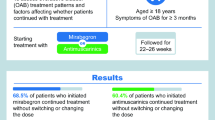Abstract
Bladder retraining and anticholinergic drugs in women with urge urinary incontinence need to be compared. Women with urge urinary incontinence were recruited by advertisements, from primary care and from a urogynaecology clinic. Women were randomised using a web page to bladder retraining, anticholinergic drugs or both and followed up at 3 and 12 months. No blinding was attempted. The primary outcomes were the trial process and the Overactive Bladder Questionnaire (OAB-q) quality-of-life measure. Recruitment was much slower than anticipated. There were no differences in the OAB-q at 12 months (87.9 SD 11.6 bladder retraining, 81.6 SD 19.3 drug therapy and 88.9 SD 9.9 combination) but dry mouth was more common in those taking drugs. It is feasible to run a pragmatic randomised trial with 12-month follow-up for women with urinary urge incontinence. This will require about 500 participants per arm.

Similar content being viewed by others
References
Abrams P, Cardozo L, Fall M, Griffiths D, Rosier P, Ulmsten U et al (2002) The standardisation of terminology of lower urinary tract function: report from the Standardisation Sub-committee of the International Continence Society. Neurourol Urodyn 21:167–178
Milsom I, Abrams P, Cardozo L, Roberts RG, Thuroff J, Wein AJ (2001) How widespread are the symptoms of an overactive bladder and how are they managed? A population-based prevalence study. BJU International 87:760–766
Stewart WF, Van Rooyen JB, Cundiff GW, Abrams P, Herzog AR, Corey R et al (2003) Prevalence and burden of overactive bladder in the United States. World J Urol 20:327–336
Liberman JN, Hunt TL, Stewart WF, Wein A, Zhou Z, Herzog AR et al (2001) Health-related quality of life among adults with symptoms of overactive bladder: results from a U.S. community-based survey. Urology 57:1044–1050
van der Vaart CH, de Leeuw JR, Roovers JP, Heintz AP (2002) The effect of urinary incontinence and overactive bladder symptoms on quality of life in young women. BJU Int 90:544–549
Dmochowski RR, Newman DK (2007) Impact of overactive bladder on women in the United States: results of a national survey. Curr Med Res Opin 23:65–76
Grimby A, Milsom I, Molander U, Wiklund I, Ekelund P (1993) The influence of urinary incontinence on the quality of life of elderly women. Age Ageing 22:82–89
Lowenstein L, Brubaker L, Kenton K, Kramer H, Shott S, FitzGerald MP (2007) Prevalence and impact of nocturia in a urogynecologic population. Int Urogynecol J 18:1049–1052
Coyne KS, Margolis MK, Jumadilova Z, Bavendam T, Mueller E, Rogers R (2007) Overactive bladder and women’s sexual health: what is the impact? J Sexual Med 4:656–666
Abrams P, Cardozo L, Khoury S, Wein A (eds) (2005) In: Incontinence. vol. 2. Health Publication Ltd., Plymouth
Wallace SA, Roe B, Williams K, Palmer M (2004) Bladder training for urinary incontinence in adults. Cochrane Database of Systematic Reviews 2004, Issue 1. Art. No.: CD001308. doi:10.1002/14651858.CD001308.pub2
Nabi G, Cody JD, Ellis G, Herbison P, Hay-Smith J (2006) Anticholinergic drugs versus placebo for overactive bladder syndrome in adults. Cochrane Database of Systematic Reviews 2006, Issue 4. Art. No.: CD003781. doi:10.1002/14651858.CD003781.pub2
Herbison P, Hay-Smith J, Ellis G, Moore K (2003) Effectiveness of anticholinergic drugs compared with placebo in the treatment of overactive bladder syndrome: systematic review. BMJ 326:841–844
Song C, Park JT, Heo KO, Lee KS, Choo MS (2006) Effects of bladder training and/or tolterodine in female patients with overactive bladder syndrome: a prospective, randomized study. J Korean Med Sci 21:1060–1063
Colombo M, Zanetta G, Scalambrino S, Milani R (1995) Oxybutynin and bladder training in the management of female urinary urge incontinence: a randomized study. Int Urogynecol J 6:63–67
Ghei M, Miller R, Malone-Lee J (2006) Case series data to encourage randomized trials of bladder retraining compared to antimuscarinic agents. J Urol 175:1411–1415
Roland M, Torgerson DJ (1998) Understanding controlled trials. What are pragmatic trials? BMJ 316:285
Coyne K, Revicki D, Hunt T, Corey R, Stewart W, Bentkover J et al (2002) Psychometric validation of an overactive bladder symptom and health-related quality of life questionnaire: the OAB-q. Qual Life Res 11:563–574
Karantanis E, Fynes M, Moore KH, Stanton SL (2004) Comparison of the ICIQ-SF and 24-hour pad tests with other measures for evaluating the severity of urodynamic stress incontinence. Int Urogynecol J 15:111–116
Coyne KS, Matza LS, Thompson CL, Kopp ZS, Khullar V (2006) Determining the importance of change in the overactive bladder questionnaire. J Urol 176:627–632
Rothwell PM (2005) Treating individuals 1. External validity of randomised controlled trials: “to whom do the results of this trial apply?”. Lancet 365:82–93
Acknowledgements
Funding for this study was from an Otago Research Grant (Reference No. 200200495) from the University of Otago.
Disclosure of interests
All authors declare that they have no conflicts of interest.
Author information
Authors and Affiliations
Corresponding author
Additional information
Trial registration
This trial was registered as ISRCTN 66713401.
Rights and permissions
About this article
Cite this article
Lauti, M., Herbison, P., Hay-Smith, J. et al. Anticholinergic drugs, bladder retraining and their combination for urge urinary incontinence: a pilot randomised trial. Int Urogynecol J 19, 1533–1543 (2008). https://doi.org/10.1007/s00192-008-0686-8
Received:
Accepted:
Published:
Issue Date:
DOI: https://doi.org/10.1007/s00192-008-0686-8




